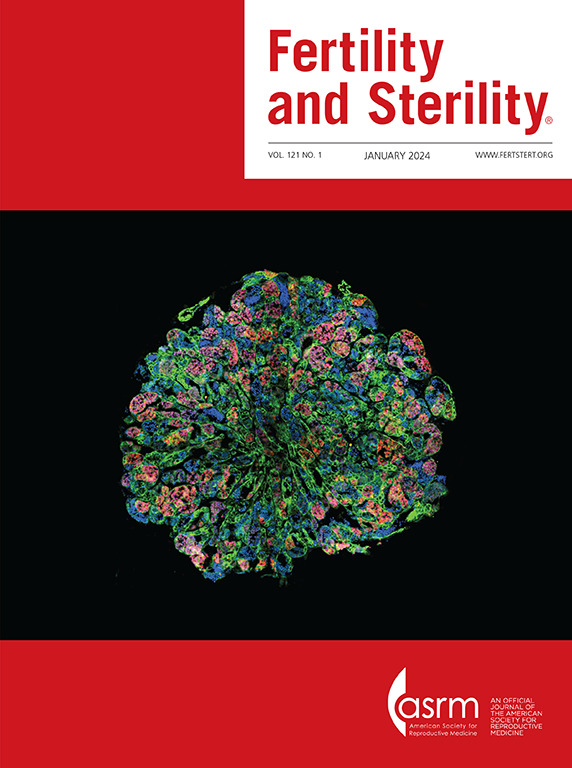Male obesity impairs early embryonic development and increases miscarriage risk in oocyte donation cycles.
IF 7
1区 医学
Q1 OBSTETRICS & GYNECOLOGY
引用次数: 0
Abstract
OBJECTIVE To evaluate the impact of male body mass index (BMI) on preimplantation development and clinical outcomes in oocyte donation cycles. DESIGN Retrospective cohort study. SUBJECTS A total of 7,846 embryos from 1,398 oocyte donation ICSI cycles were analyzed. Cycles utilized fresh (n = 904) or cryopreserved (n = 494), partner (n = 1,133) or donor sperm (n = 265). Cycles involving severe male factor or preimplantation genetic testing were excluded. EXPOSURE Male body mass index (BMI, kg/m2) at cycle start, categorized as normal weight (BMI < 24.9, n = 699), overweight (BMI = 25.0-29.9, n = 561), or obese (BMI ≥ 30, n = 138). MAIN OUTCOME MEASURES The primary outcome focused on the timing of preimplantation developmental milestones assessed through morphokinetics. Secondary outcomes included embryo quality, fertilization, blastocyst, implantation, miscarriage, and live birth rates. Outcomes of the first fresh (n = 1,136) or frozen (n = 200), cleavage (n = 422) or blastocyst stage (n = 914) transfer were included, comprising 1,097 single and 239 double embryo transfers. Univariate analyses and logistic regression were used to evaluate associations between BMI, embryo morphokinetics and clinical outcomes. RESULTS Embryos from obese males showed delayed cleavage-stage development (t2, t3, t4, and t5) and reduced odds of a good-quality inner cell mass in blastocysts, compared to those from normal weight males (OR = 0.80; 95% CI = 0.64-0.99; p = 0.04). Fertilization (normal weight: 75.1%, overweight: 74.6%, obese: 73.1%) and blastocyst rates (normal weight: 65.1%, overweight: 63.6%, obese: 63.8%) were comparable among the BMI groups. Implantation (normal weight: 64.8%, overweight: 64.3%, obese: 58.7%) and clinical pregnancy rates (normal weight: 60.0%, overweight: 58.9%, obese: 52.9%) were also similar. However, miscarriage rates were significantly higher among couples with obese males (13.5%) compared to those with normal weight males (9.5%) (OR = 1.67; 95% CI = 1.27-2.19; p = 0.0002). While not statistically significant, live birth rates followed a similar trend (normal weight: 46.7%, overweight: 43.7%, obese: 36.5%). CONCLUSION Male obesity impairs early embryonic development and increases miscarriage rates, identifying male BMI as a potential risk factor in oocyte donation cycles.男性肥胖损害早期胚胎发育,增加卵子捐赠周期流产风险。
目的探讨男性体重指数(BMI)对卵母细胞捐献周期植入前发育及临床结局的影响。设计回顾性队列研究。对1398个卵母细胞捐赠ICSI周期的7846个胚胎进行了分析。周期使用新鲜精子(n = 904)或冷冻精子(n = 494),伴侣精子(n = 1133)或供体精子(n = 265)。包括严重男性因素或植入前基因检测的周期被排除在外。周期开始时男性体重指数(BMI, kg/m2),分为正常体重(BMI < 24.9, n = 699)、超重(BMI = 25.0-29.9, n = 561)或肥胖(BMI≥30,n = 138)。主要结局指标主要结局集中于通过形态动力学评估的着床前发育里程碑的时间。次要结局包括胚胎质量、受精、囊胚、着床、流产和活产率。包括首次新鲜(n = 1136)或冷冻(n = 200)、卵裂(n = 422)或囊胚期(n = 914)移植的结果,包括1097例单胚胎移植和239例双胚胎移植。采用单因素分析和逻辑回归来评估BMI、胚胎形态动力学和临床结果之间的关系。结果与体重正常的男性相比,肥胖男性的胚胎表现为卵裂期发育(t2、t3、t4和t5)延迟,囊胚形成优质内细胞团的几率降低(OR = 0.80; 95% CI = 0.64-0.99; p = 0.04)。BMI组受精率(正常体重:75.1%,超重:74.6%,肥胖:73.1%)和囊胚率(正常体重:65.1%,超重:63.6%,肥胖:63.8%)具有可比性。着床率(正常体重:64.8%,超重:64.3%,肥胖:58.7%)和临床妊娠率(正常体重:60.0%,超重:58.9%,肥胖:52.9%)也相似。然而,男性肥胖夫妇的流产率(13.5%)明显高于男性正常体重夫妇(9.5%)(OR = 1.67; 95% CI = 1.27-2.19; p = 0.0002)。虽然没有统计学意义,但活产率也有类似的趋势(正常体重:46.7%,超重:43.7%,肥胖:36.5%)。结论男性肥胖损害早期胚胎发育,增加流产率,男性BMI是卵母细胞捐献周期的潜在危险因素。
本文章由计算机程序翻译,如有差异,请以英文原文为准。
求助全文
约1分钟内获得全文
求助全文
来源期刊

Fertility and sterility
医学-妇产科学
CiteScore
11.30
自引率
6.00%
发文量
1446
审稿时长
31 days
期刊介绍:
Fertility and Sterility® is an international journal for obstetricians, gynecologists, reproductive endocrinologists, urologists, basic scientists and others who treat and investigate problems of infertility and human reproductive disorders. The journal publishes juried original scientific articles in clinical and laboratory research relevant to reproductive endocrinology, urology, andrology, physiology, immunology, genetics, contraception, and menopause. Fertility and Sterility® encourages and supports meaningful basic and clinical research, and facilitates and promotes excellence in professional education, in the field of reproductive medicine.
 求助内容:
求助内容: 应助结果提醒方式:
应助结果提醒方式:


